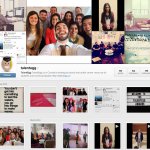Video content for campus recruitment purposes is on the rise, and it’s because Generation Y likes to consume information they can connect with.
Today’s students and grads have grown up in a very unique environment, one where information has become increasingly visual. From YouTube to Instagram, it’s now better to be seen and heard.
“[Gen Y is] a generation that likes to take in content and have some sort of emotional reaction to it.” Lauren Friese, founder of TalentEgg, explains.
“Visuals are a really great way of doing that.”
Incorporating visual elements into your campus recruitment strategy can help you broadcast your recruitment message in an organic way, consistent with the information students and grads are already interacting with.
Video content is easy to incorporate into your branding efforts. Whether you’re a smartphone videographer or a blockbuster star, there are a few key elements to remember:
Concept
Visual content for visual content’s sake is all well and good, but an effective creative strategy needs direction.
Before you begin your video project, decide on its intended purpose. If you’re working with a partner like TalentEgg to create your content, the ideation process is done for you. Content specialists come up with different concept ideas based on your recruitment objectives, and work with you to focus the project around your goals.
Working on your video in-house? Consider a few initial questions to guide your brainstorming:
- How should viewers feel after watching this video? Inspired? Informed?
- Should this video explore one aspect of our employer brand or many?
- Do we want to create an advice-driven video? What would the topic be?
- Where will this video be the most useful? On social media, on our campus careers page or used in on-campus engagements?
By answering these questions, you’ll build a solid foundation for the rest of the project.
Plot
Truly engaging video content has a story to tell. Epic romance set aboard a doomed ocean liner in the early 1900’s? Great idea, but it’s not quite what we had in mind.
A great marketing video is able to connect its message to its audience through active storytelling, so whether you’re working from a script or a questionnaire, a simple, overarching storyline can inform the emotional response viewers have to your content.
To create a compelling story, start by breaking it down into three parts: the beginning, the middle and the end. The beginning should be able to present your concept and characters without being too overt–one way to achieve this would be to introduce video participants to the audience.
The middle is where the heart of your concept should be; if the intended purpose of your video is to promote different career opportunities within your IT department, focus a majority of the storyline around your subject with the questions you ask or script you write.
The end of the story should leave your viewers with a powerful, positive impression of your employer brand. A sentimental quote about how great it is to work at your organization would be perfect here.
Characters
If you want Gen Y viewers to connect and identify with your video, you need to pick the right people for the role.
It doesn’t matter if your workforce is in the hundreds or less than twenty, your casting choices need to be able to share their thoughts in an eloquent, but natural manner. They’re your brand’s on-camera ambassadors – they need to convince students and grads that your employer brand is for them.
When casting, try to approach the situation as if you were recruiting for an open job opportunity. You want to find a strong candidate who embodies their role, your brand and culture.
If you can, be as diverse in your selection as possible so that many different voices are represented (so long as it is an accurate depiction of your workforce). Video participants will also have to fit within your overall concept: if you’re producing a video on your student internship program, you’ll likely want to cast Gen Y participants.
Cuts
If nothing else, the most important part of a great marketing video is b-roll footage.
B-roll is the footage used to establish your overall concept, enrich your story and add visual interest to your video. Think of it this way: if a-roll is your main footage – employees talking at the camera about what they love about your organization – b-roll is everything else.
Of course, to add any value, b-roll has to have a purpose, too.
For character-driven content, b-roll typically involves capturing video participants doing things related to the overarching story: an IT analyst working at their desk, or a co-op student meeting with their employee mentor.
For general content, relevant, everyday details can be used for b-roll: objects on someone’s desk or an interesting office space. Details make for great footage and can help set the scene for viewers looking for additional context.
To ensure you capture egg-cellent b-roll, add an extra hour into the production schedule and ask video participants to take part. If this isn’t possible due to scheduling, focus on other details that can help tell your story.
Discussion: Have you created video content? Share the links in the comment section below.






Leave a Reply
You must be logged in to post a comment.